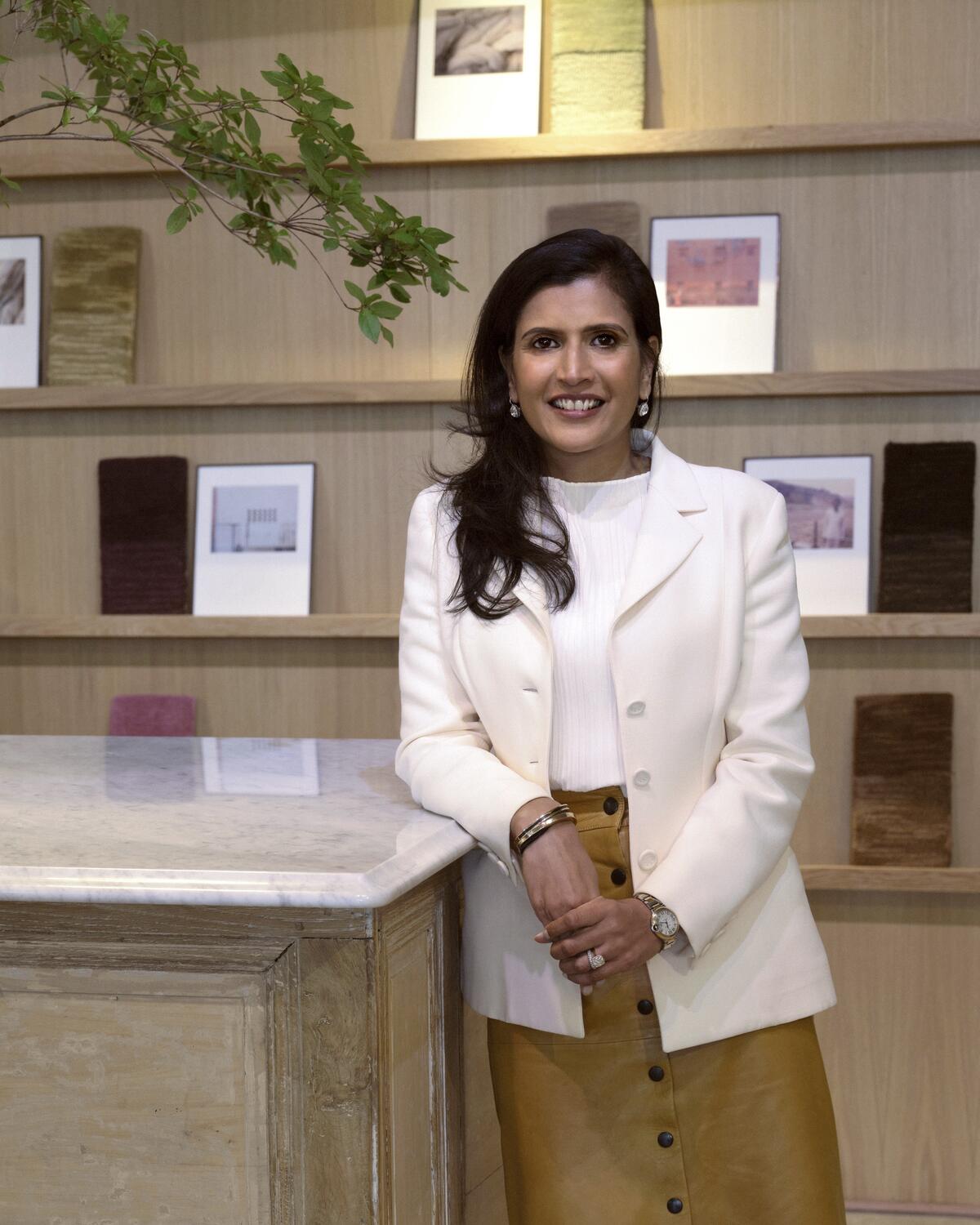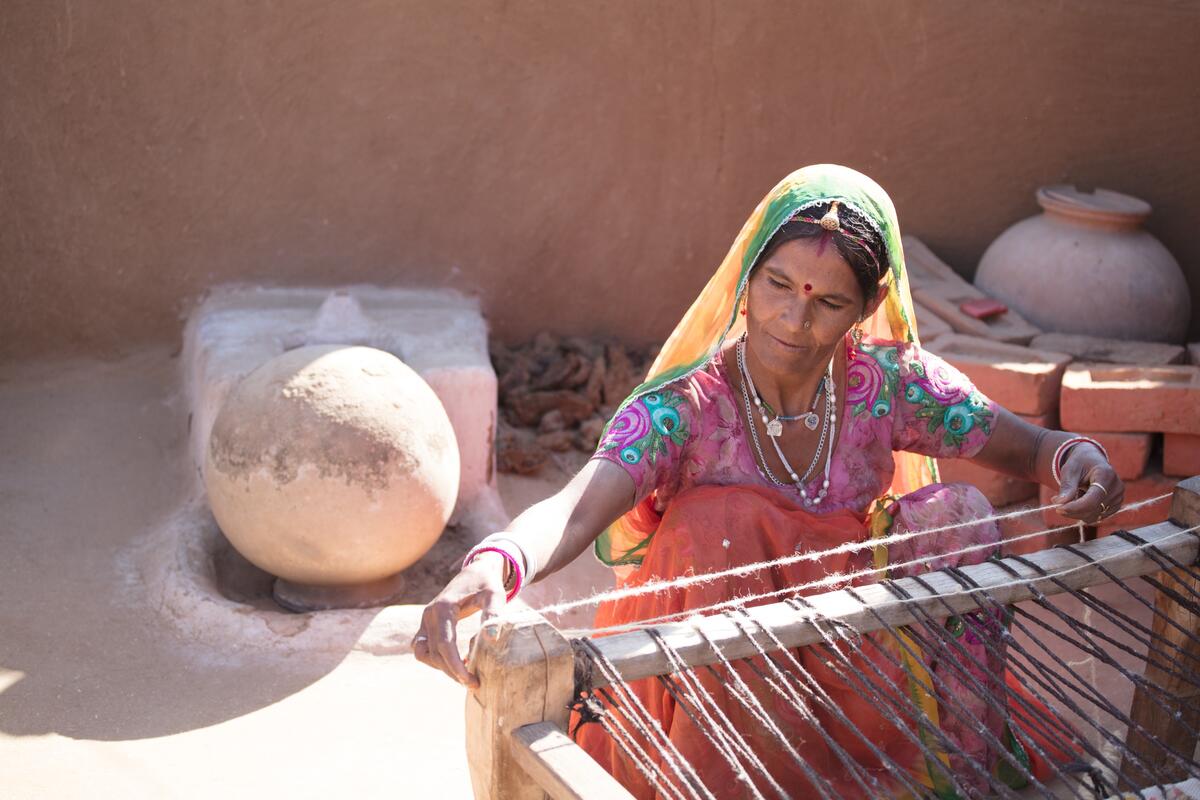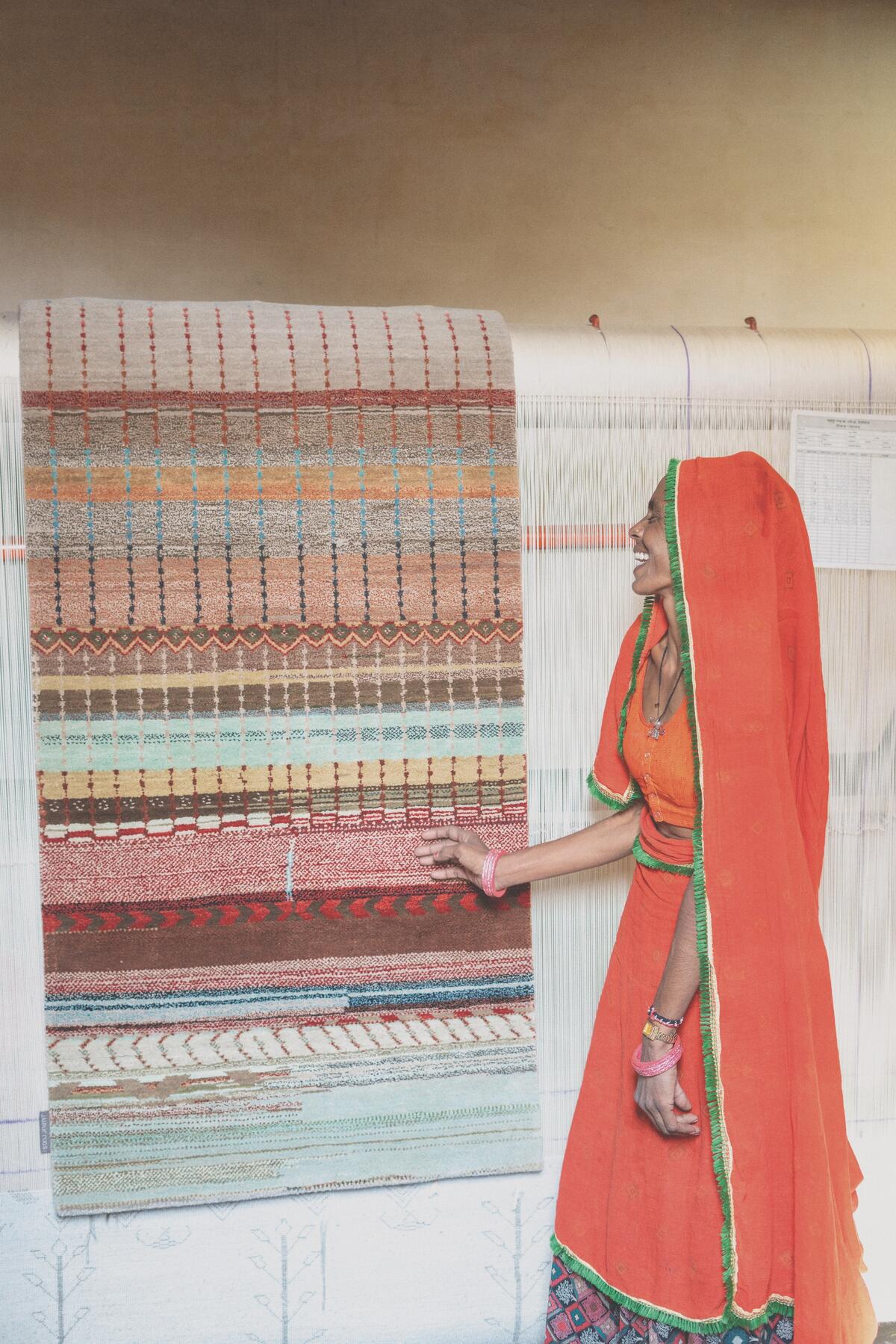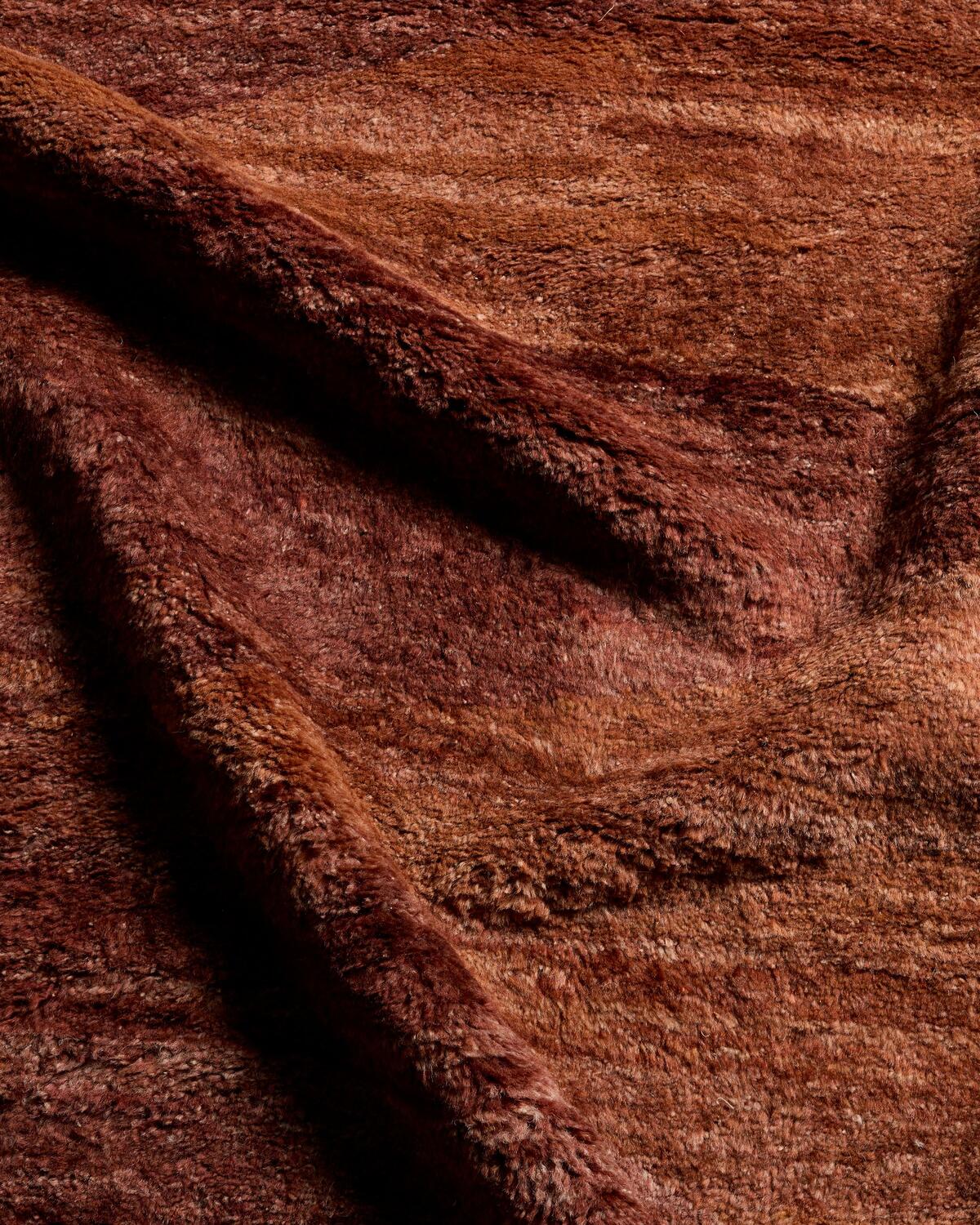Weaving together threads of tradition and innovation, every rug from Jaipur Living tells a story of commitment to craftsmanship. It starts in the hands of skilled artisans, carefully creating each piece, knot by knot by knot, one row at a time. Taking months to complete, the meticulous process results in masterpieces of breathtaking precision and beauty. For nearly 50 years as a leader in the global rug industry, the company has married the ancient art of rug-making with modern designs and sustainable practices to elevate the aesthetics of any interior—as well as the livelihoods of its workers.
From Jaipur Living’s stateside headquarters in Acworth, Georgia, CEO Asha Chaudhary spoke with Business of Home about the brand’s humble beginnings and rich heritage; the ethical practices and entrepreneurial model that have transformed the outlooks of thousands of women across India; the sustainability initiative that surprisingly became an award-winning showcase for utterly original works of art; and the many ways the company continues to revolutionize the rug category.
Jaipur Living is renowned for its artisanal, hand-knotted rugs. What tenets define the company’s approach to the craft?

First is what we call the “artisan proposition.” We operate at the grassroots level. Our artisans work out of their homes. Since my dad, N.K. Chaudhary, started the business 46 years ago, in 1978, we’ve done an amazing job harnessing the creative capabilities of our craftspeople, helping connect their beautiful work with the bigger world of design.
Another core principle of our business is our commitment to a vertical, and ethical, supply chain. We have a saying that “we own everything but the sheep.” We facilitate every process in-house, controlling production from start to finish. We buy our own yarn, cure it, process it, and work directly with all our artisans. It ensures a consistent, high-quality product for our customers.
Sustainability is the third component. It informs not just our raw materials but our eco-conscious production methods. We have a small environmental footprint and are determined to leave the world in a safer and better place. We believe how our rugs are made is as important as the rugs themselves.
Many companies are motivated first and foremost by profit. Meanwhile, Jaipur Living prioritizes the welfare of its artisans, ensuring that they earn a livable wage. What accounts for that distinction?
I don’t think my dad initially set out expecting to support the volume of artisans that we do today. It was important to him that our family was taken care of and that we had food on the table. But he was able to pair his deep love of rug-making with his desire to build a purpose-driven business. He quickly realized that you can both be profitable and transform lives. He saw how artisans were being treated, how middlemen were taking the bulk of their income, and he recognized something was wrong. So he started working directly with the weavers instead, training them and paying them better. But as he was building the company, he wasn’t thinking: “I’m creating all this positive societal impact.” He just felt that businesses should be run on basic principles of human dignity. He began with two looms, and it expanded to become the world’s largest manufacturer of hand-knotted rugs.

That respect for your workers must foster a lot of loyalty.
Yes, it’s a reciprocal relationship. We are a network of 40,000-plus artisans, the majority of whom have been with us for years. I call them the world’s most masterful craftspeople because of how much talent and training they have.
We always encourage our customers to visit our operations. Those who do describe it as an incredibly inspirational experience. When I returned to India for the first time following Covid, after a few years away, I went to one of the villages and met with one of our artisans. She was relatively new to the company, so I asked her, “How do you feel working with us versus where you worked before?” And she said, “The biggest difference is that I don’t wear the veil anymore.” In India, most women in rural villages dress in saris and don’t show their faces. But she said, “Now I take my veil off and walk with pride.” Working with us had transformed her self-esteem.
With 40,000-plus artisans, does the brand have workplaces throughout India?

Our head offices are in Jaipur, the capital of Rajasthan, and we work in approximately 30 to 40 villages in that region alone. Bikaner is where we source and process all our yarn. We have about 8,000 artisans there, hand-carding the yarn and preparing it to be dyed. We do a lot of our high-end rug manufacturing in Gora. All told, Jaipur Living is now in about 700 different villages across four different states in India.
The centuries-old art of rug-making is at risk of being lost. If you consider all the different countries that used to create handmade rugs, like Iran and Pakistan, Afghanistan and China, unfortunately their output has been eroding from the map. Our goal is to connect this amazing craft to consumers today through beautiful designs, expert techniques and technological innovation, bringing the old and the new together in heirloom-worthy products that speak to modern aesthetics and last for generations. How do we make sure this craft stays alive? Part of it has to do with how we treat the artisans. And on the consumer side, with the advancements in mass production over the last several years, the onus is on us to educate the customer about the significance and beauty of handmade rugs.
How does Jaipur Living’s “doorstep entrepreneur model” support those goals?
It takes the supply chain quite literally to the doorsteps of the artisan. We put the looms in their house, drop off the raw materials, and retrieve the finished product once it’s done. Eighty-five percent of our craftspeople are women, and this enables them to support their families financially and also stay at home to provide care. In rural villages, outside of laboring in the fields, there’s no other way to earn an income. By working at the grassroots level, the women are able to care for their children throughout the day. It offers the same advantages of working from home that we talk about in the States, saving the time and expense of childcare and commuting by bus to a city center for a job.
One of our artisans, a woman named Vila, had four young kids and was living below the poverty line. Her husband was an alcoholic and never made enough money. She didn’t have the flexibility to travel to a job, so she came to us. We put a loom in her house and taught her how to weave. And she realized, wow, she could solicit other women in the village. So, we provided a second loom, and then a third. Now 120 other women are working for her. She’s become a leader in her small community.

On a holistic level, we run many different programs that help empower women. We offer education and health care, building awareness around both physical and mental well-being. One of my all-time favorite programs has been helping our artisans open their own bank accounts. Not all women were set up for success. We know of situations where the husbands controlled the money and didn’t always use it to support their families. But when women control their own finances, they can care for their kids, make improvements to their homes, and save for the long-term.
How does the Manchaha program fit into this picture?
Sustainability is a huge part of our mission, and the ethical treatment of our artisans is just one aspect of it. Another has to do with the materials we use. We source a lot of raw materials that are earth-friendly. A lot of natural fibers. And we’re mindful of sustainability in our production processes. When dyeing yarn, for example, we treat the water so that it’s toxin-free, making sure we’re not disposing of any harmful chemicals into the environment. In general, handmade rug production has very little negative environmental impact.

Manchaha first came about as a sustainability initiative. Every time an artisan finishes a rug, there’s always a little yarn left over. To ensure color consistency, we try not to mix different batches, in case there’s a slight variation in the shades. Instead, we encouraged our artisans to get creative, saying, “Hey, we have this scrap yarn. Pick whatever colors you like and make whatever comes to mind.” In Hindi, manchaha means “from the heart.” The idea was that the artisan would freely express their own vision, tell their own story, without following a weaving map. They started to make the most unbelievably beautiful, completely original pieces, truly pushing the boundaries of contemporary design. Some rugs had 80 colors. You could never, ever replicate them.
What began as a way to repurpose yarn has now won 22 different design awards. And it represents another evolution for the workers, from laborer to artisan to artist. Every rug in the collection has the stamp of its maker and comes with a framed statement that includes her name, where she lives, and a description of the inspiration behind her design. In the United States, the program is still relatively new, but globally, especially at our retail stores in India and London, a lot of celebrities, artists and collectors who have a passion for unique pieces want Manchaha rugs in their homes. They even come to us now and say, “Here are my room measurements, this is my preferred color palette: What can you make for me?” We’ll give the brief to the artisan, and they’ll take it from there.
It sounds like a word-of-mouth phenomenon!
We didn’t put a ton of marketing behind it. But once you have a Manchaha rug, it becomes a conversation piece. Everybody wants to talk about it. It’s a limited program, and it certainly challenges the status quo, but it’s been incredible to see how it has grown organically.

The Manchaha designs are one-of-a-kind by definition, but what distinguishes your more mainstream offerings?
On average, our rugs have about a million hand-knots apiece. Our 10-step process encompasses everything from how we source the yarn to the 180-plus hands a rug passes through before it’s finished. In addition to the beauty and craftsmanship of the product, the culture we’ve built and the customer experience we offer differentiates us. Whether through our digital tools, our knowledgeable sales team, or the benefits of our trade program, we make sure to meet their needs at every stage of the transaction.
Separate from natural wool, do you offer rugs in performance materials like solution-dyed acrylic and PET yarns?

We understand that rugs are not just aesthetic. Customers also need solutions to today’s demands: kids and pets and everything else that goes on in a home. They need cleanability. We’re totally invested in working with materials that deliver functionality while still leaving a light environmental footprint.
From a luxury perspective, customers often want natural fibers like wool, hemp and silk—there’s nothing more magical. But solution-dyed acrylic can be as expensive as wool because of its performance capacities: You can spill wine on it; it’s easy to clean; it’s bleach-friendly. What we’ve seen is that sometimes it’s not just the price, but also how a product stands up to wear and tear that determines its value to the consumer.
Looking ahead, we’ll soon be sealing many of our rugs, no matter their content. We’re launching an optional stain protectant to make our products even easier to maintain. The formula is 99 percent water-based and toxin-free. We’ve done a lot of research; we’ve been developing it for three years, and we’re super excited to introduce it, knowing that cleanability is one of the bigger pain points for customers.
What other new designs or programs are in the works at Jaipur Living?
Coming out of Covid, there’s a whole movement toward simplicity. Textures, warmer tones, modern designs and midcentury aesthetics are all resonating. We have a new partnership with Michael Habachy, who is one of the top interior designers in the Southeast, and we’re also collaborating with House Sprucing, a brand based in Dallas, on a collection. We continue to develop our custom program, where you don’t have to pay thousands of dollars to have a rug designed in a special size or color palette you’ve always wanted but haven’t found. Not to mention that there are so many other exciting things on the horizon.

This story is a paid promotion and was created in partnership with Jaipur Living.
Homepage image: A tapestry of stories and traditions, the Kakero rug is rich in meaning: Its vibrant flower motif recalls a cherished wedding gift given to the artisan, and other symbolic touchstones include ocean waves, mountainscapes, leopard spots and fallen leaves | Courtesy of Jaipur Living





























